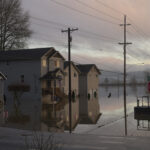The magnitude 7.0 earthquake that rattled Alaska’s largest city cracked roads and collapsed highway ramps, but there were no reports of widespread catastrophic damage or collapsed buildings.
There’s a good reason for that.
A devastating 1964 Alaska earthquake – the most powerful on record in the United States – led to stricter building codes that helped structures withstand the shifting earth Friday.
“Congratulations to the people of Alaska for being really prepared for this earthquake,” U.S. Geological Survey Geophysicist Paul Caruso said Saturday. “Because a magnitude 7.0 in a city like that, you know, it could have been significantly worse.”
Gov. Bill Walker said sometimes people, including himself, grouse about stringent building codes. But he’s “really glad” they were in place as he only had minor water damage at his home.
“Building codes mean something,” he said Friday.
The quake was centered about 7 miles (12 kilometers) north of Anchorage, which has a population of about 300,000. People ran from their offices or took cover under desks. A 5.7 aftershock arrived within minutes, followed by a series of smaller quakes.
The two big back-to-back quakes knocked items off shelves, disrupted power, broke store windows and briefly triggered a tsunami warning for islands and coastal areas south of the city. Walker issued a disaster declaration, and President Donald Trump declared an emergency, allowing the Federal Emergency Management Agency to coordinate disaster relief.
There were no reports of deaths or serious injuries.
Still, aftershocks Saturday continued to fray nerves, with people worrying about being caught in more massive shakers.
‘They’re disturbing, and I’m not putting anything away that could fall until they calm down,” Randall Cavanugh, an Anchorage attorney, said following a restless night at home. “I kept waking up.”
By mid-morning, there had been about 550 aftershocks, including 11 with magnitudes of 4.5 or greater, Caruso said.
The aftershocks should be weaker and less frequent in the coming days, but officials can’t say for sure when they’ll stop, he said.
Anchorage Mayor Ethan Berkowitz said the extent of damage was “relatively small” considering the scale of Friday’s earthquake. He also credited building codes for minimizing structure damage.
“In terms of a disaster, I think it says more about who we are than what we suffered,” he said Saturday at a press briefing, adding that Anchorage was prepared for such an emergency.
“People pulled together. We followed the plans that were in place. We looked after one another. And when people around the country and around the world look at this, they’re going to say, `We want to do things in the Anchorage way because Anchorage did this right,” Berkowitz said.
After the first earthquake, Alaska’s largest hospital activated its incident command center, but the trickle of patients into the emergency room at Providence Alaska Medical Center in Anchorage was more like a normal workday and not a mass casualty event. The injuries were described as minor, and there were no patients with life-threatening conditions.
“The flow of patients into the emergency department was similar to a typical Monday,” hospital spokesman Mikal Canfield said Saturday. “It wasn’t a situation where there was a mass rush of people.”
Roads didn’t fare so well, as reports of extensive damage came in. The Alaska Department of Transportation counted about 50 sites with damage, including eight considered major. Most of the damage was to highways north of Anchorage. The agency also was planning to conduct bridge inspections Saturday.
Transportation officials said in a release that the aftershocks continue to contribute to settling and additional cracking. Rock falls exacerbated by the aftershocks were causing some problems on the Seward Highway south of Anchorage.
Normal operations resumed at Ted Stevens Anchorage International Airport after flight operations were suspended Friday, Transportation Department spokesman Meadow Bailey told The Associated Press.
The 800-mile (1,287-kilometer) trans Alaska oil pipeline was shut down for hours while crews were sent to inspect it for damage. Michelle Egan with Alyeska Pipeline Service Co., the pipeline operator, said the line was restarted at 3:30 p.m. Friday. She said there are no obvious signs of damage and no operational impact on the pipeline, whose closest section is 120 miles (193 kilometers) from the epicenter.
Anchorage’s school system canceled classes through Tuesday while it examined buildings for damage.
Alaska’s 1964 earthquake, with a 9.2 magnitude, was centered about 75 miles (120 kilometers) east of Anchorage. It and the tsunami it triggered claimed about 130 lives.
The state averages 40,000 earthquakes a year, with more large quakes than the 49 other states combined. Southern Alaska has a high risk of earthquakes because the Earth’s plates slide past each other under the region, but it is rare for major quakes to strike so close heavily populated areas.
(Associated Press writers Becky Bohrer in Juneau, Alaska; Dan Joling in Anchorage; Gillian Flaccus in Portland, Oregon; Gene Johnson in Seattle; Jennifer Kelleher, Audrey McAvoy and Caleb Jones in Honolulu; Rachel La Corte in Olympia, Washington; and John Antczak in Los Angeles contributed to this report.)
Was this article valuable?
Here are more articles you may enjoy.

 Zillow Deleting Climate Risk Scores Reveals Limits of Flood, Fire Data
Zillow Deleting Climate Risk Scores Reveals Limits of Flood, Fire Data  Pacific Northwest Braces for Even More Flooding Rain This Week
Pacific Northwest Braces for Even More Flooding Rain This Week  LA Fires Push Insurers’ 2025 Disaster Losses to $107 Billion
LA Fires Push Insurers’ 2025 Disaster Losses to $107 Billion  ‘Dream Is in Sight:’ Chamber, Reinsurers, Insurers Urge Florida to Stay the Course
‘Dream Is in Sight:’ Chamber, Reinsurers, Insurers Urge Florida to Stay the Course 